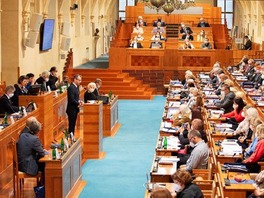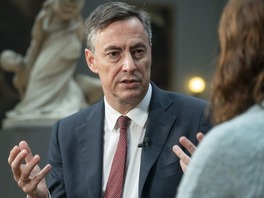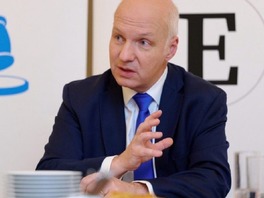Ukrainian politician Mustafa Nayem believes that the new large-scale economic agreement proposed by US President Donald Trump is not a threat, but a potential opportunity. However, on the condition that Ukraine exercises its right to review it.
Nayem posted a detailed analysis of the deal on his Facebook page.
Bloomberg, Financial Times, The Economist, The New York Times, WSJ, Politico, Forbes, Ukrainska Pravda, Dzerkalo Tyzhnia, NV, LB, Babel have already written about the agreement with the US on the creation of the fund. The fact of its existence has been acknowledged and not denied. As have the key details set out in numerous analytical materials.
The deal ended up with me too — not from sources in the Ukrainian or American government, and certainly not from individuals or structures that could even theoretically be connected to Russia.
I conducted my own analysis of this document and I believe it is right that those who really need to understand the essence should be able to read it: lawyers, economists, analysts, the public. The text of the agreement itself — with the permission of those who gave it to me — is being published openly for the first time on my Telegram channel, the link will be in the comments. And here I present a concise (though not short) analysis for those who are too lazy to read the entire document.
This is not an attempt to break the deal or stop the process. There is criticism here — and it is harsh in places. But it is primarily an attempt to understand without illusions: who controls the fund, what powers Ukraine has, what we are investing — and what we will actually get.
In the end, I gave specific suggestions for what needs to be changed. And if you read to the end, it will become clear: this agreement is not a threat, but a potential opportunity. But only on the condition that we exercise our right to review it.
WHAT IS A FUND?
So this is the final draft of the agreement between Ukraine and the US government on the creation of the Reconstruction Investment Fund. It was prepared by Freshfields lawyers, the customer is DFC - the American state financial corporation. On the cover - US-Ukraine Reconstruction Investment Fund: a partnership for reconstruction. Inside - a strict corporate agreement, written in the language of the state of Delaware. The design is simple: the US - makes decisions, Ukraine - transfers resources and takes on obligations.
The fund referred to in the agreement is not an account for donor aid, a co-financing program, or a grant platform. It is a classic investment instrument: with profitability, participation units, risks, managers, and a completely clear logic - whoever manages, benefits.
It is created as a partnership – under American law, under the jurisdiction of the state of Delaware. Ukraine in this partnership is a limited partner (Limited Partner). That is, without the right to make decisions. It manages the General Partner fund, which is appointed exclusively by the American side (through the DFC). Ukraine has no influence on his choice, his replacement, or his actions.
The General Partner has complete freedom to create new companies, move assets, change regulations, reassess contributions, determine profitability, and even change the agreement itself (with the approval of the DFC).
Ukraine, for its part, transfers to the fund "Royalty Interest" - the right to a share of income from future projects. But the value of this asset, the accounting procedure, the volume of obligations and currency terms are determined by the same General Partner. All risks are on us, all leverage is on him.
This is a complex institutional structure – a fund of funds, with the ability to create sub-platforms, management companies, financial instruments. But in this entire architecture, Ukraine is always a passive party. Formally, we are a “partner”, but without access to the steering wheel.
HOW IT WORKS
The fund is registered in the USA. The office is in the USA. The law is American. Key decisions are made by the General Partner, who is appointed by the DFC. Ukraine does not even have basic protection for a minority partner in this structure.
General Partner alone:
- opens accounts,
- creates management companies,
- determines the regulations and changes them at any time,
- forms councils and committees,
- elects “authorized persons” – who can act in any jurisdiction, in any form.
Ukraine does not approve these decisions, does not make amendments, and does not have the right to veto. Its role is limited to participation in the fund's Board, where it is in the minority from the beginning: 3 votes from the United States, 2 from Ukraine. And all decisions are made by a simple majority.
In addition, DFC has a Class C Unit – a “golden share”, which gives the right to block any decision. Ukraine does not have such a right. And even if Ukrainian representatives do not agree or do not show up for the meeting, the fund continues to work – unilaterally.
All of these are not exceptions, but a fixed structure. It allows the General Partner to manage the fund without any approvals, consultations or obligations to the Ukrainian side. Formally - a partnership. In essence - full control from one side.
WHAT EACH PARTY CONTRIBUTES
In the minds of many, the US gives money, Ukraine receives investments. But in reality, everything is more complicated.
DFC invests “capital” in the form of assistance already provided to Ukraine – military, technical, consulting. In other words: what has already been done is formally counted as Initial Contribution. The fund will not receive money from DFC immediately.
Ukraine transfers a resource that has real economic value – Royalty Interest. This is the right to income from projects: minerals, infrastructure, energy, privatization. And although the source of this value is Ukrainian assets – the General Partner evaluates them at its own discretion. Without an independent audit. Without the participation of Ukraine.
And then - even more interesting:
- all cash flows of the fund are in US dollars. If currency restrictions are in effect in Ukraine, we are obliged to compensate the fund for any losses;
- Ukraine does not have the right to withdraw from the fund, demand the return of its share or transfer it to another participant. DFC – can;
- DFC contribution is priority: it is returned first, with profit. Ukrainian contribution – only after that.
All mechanisms of capital, management, revaluation and distribution are written so that the General Partner has full control. Ukraine has full responsibility without protection tools.
WHY IS IT RISKY?
Creating a fund in this form is not just an institutional partnership. It is a large-scale legal construction in which Ukraine assumes obligations without having any tools for influence, protection, or exit. And the risks here are not isolated - they are systemic.
Complete dependence on the General Partner
The General Partner doesn't just manage the fund - he appoints himself, changes the agreement without our participation, determines what documents exist and how they are interpreted. We have no say in making strategic decisions, even when it comes to managing assets in Ukraine.
A General Partner can:
- change rules, structure, procedures and committees;
- appoint and remove Ukrainian representatives;
- make investment decisions without taking into account the national interests of Ukraine;
- completely ignore Ukraine's position even in the event of systemic damage to it.
Unlimited legal and financial liability of Ukraine
The agreement provides that Ukraine will compensate for losses not only for its actions, but also for any claims against the fund, the General Partner, DFC or their affiliates. These obligations:
- have no upper limit on the amount;
- are valid indefinitely, even after the liquidation of the fund;
- cover costs of courts, lawyers, consultations, taxes, fines and penalties;
- arise even without our knowledge or participation in the disputed situation.
In fact, the state assumes guarantees for other people's activities, which it does not manage.
Deprivation of investment, fiscal and information sovereignty
Ukraine undertakes to:
- not tax the fund,
- provide unlimited conversion into dollars,
- not to interfere in the structure of agreements,
- not to change regulatory acts that may interfere with the work of the RISK Fund.
Even public disclosure of information is only possible with the permission of the General Partner. And the fund is allowed to work in other jurisdictions, invest outside of Ukraine, and attract resources without taking into account national priorities.
Fixing inequality in rights, but not in responsibilities
DFC gets a “golden share”, priority payments, the right to offtake Ukrainian resources and automatic access to any projects. Ukraine has none of this.
We cannot:
- withdraw from the fund;
- transfer your share;
- influence the use of our resources;
- impose restrictions on the activities of the General Partner;
- initiate proceedings in a court outside the jurisdiction of the United States.
And even if the fund suffers losses due to the actions of the General Partner, it is not liable.
Loss of strategic positions – resource, legal, managerial
The agreement directly obliges Ukraine to:
- provide the US with first access to projects in the mining sector, infrastructure, and logistics;
- open strategic commercial documentation;
- agree to conditions that scare away other investors;
- ensure compliance with the fund's terms and conditions even in the event of changes in legislation or the political situation.
This is a de facto transfer of control over access to strategic resources to a foreign player – without mirror rights, without balance, without guarantees of protection.
WHAT TO DO
The current version of the agreement is a technical proposal from the American side, developed with a focus on maximum flexibility for the DFC and General Partner. Ukraine does not yet have any powers, guarantees, or real access to management in this structure. But this is not a dogma, not a final, not a verdict. And right now is the best time to turn this architecture into a partnership model that works for both sides.
To do this, it is necessary to make a number of amendments that will balance powers, limit financial risks, and ensure transparency.
Cancel or clearly limit the right of first refusal on projects and resources - it should not go beyond the fund's investments.
Review provisions on taxation, capital withdrawal, and currency control – the state should retain the right to regulate these areas within its territory.
Change the governance structure: ensure Ukraine has equal representation on the fund's board and investment committees, and grant it the right to approve key changes and decisions.
Provide Ukraine with full access to information: reporting, audit, documentation, primary data – everything related to its contribution and projects on its territory.
Limit Ukraine's liability - with clear limits on the amount, terms, and types of obligations.
Establishing that the bulk of the fund's investments are directed to Ukraine must be legally confirmed, not simply declared.
WHAT CAN IT GIVE?
Successful reformatting of this agreement opens up not a risk, but a real opportunity. And a very big one.
First, it will be the number one market signal for all international investors: Ukraine is a country where big players come, where institutions can work, where not only the state but also powerful partners take the risk. Such a precedent has much more value than just an agreement between governments – it is an institutional credit of trust.
Second, it will force Ukraine to put its investment protection system in order. If we really want big money to come here, we have to guarantee that the courts are working, the prosecutor's office is working, and the rules are in place. Otherwise, the fund simply won't work – or it will work against us. And with the right conditions, it could be a catalyst for long-overdue reforms.
Third, such a structure gives Ukraine the opportunity to influence the global agenda. We can establish a new model of cooperation with the United States - not in the format of "aid", but in the format of a true partnership: with clear rights, mutual responsibility and long-term interest.
Fourth, this fund can become a platform for other donors. If we create a transparent, honest and effective model, other states, private foundations, pension companies, technology giants can join it. This can become the basis for a large recovery coalition that goes far beyond a single project.
I really hope that the Ukrainian government will look at this agreement in this way. I know that a great team is already working - and I sincerely wish them success. Because this is another chance. And, perhaps, one of those that will never be repeated. But it is real. And we must take advantage of it .
Read also: Ukraine initiated changes to the scandalous agreement with Trump






